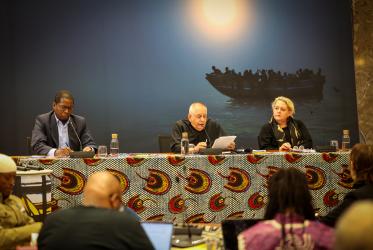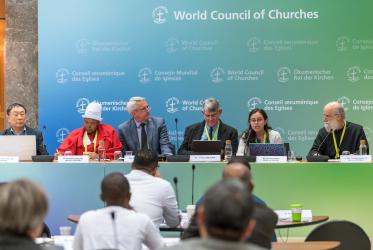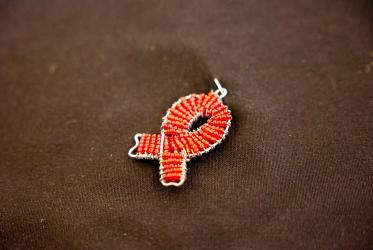Drugs and AIDS Resolution
Adopted by 2004 General Conference
Pennsylvania, United States, 27 April - 7 May 2004
According to the United Nations' AIDS estimates, approximately 40 million people worldwide are living with HIV/AIDS. Of these, two to three million are injecting drug users. Many more have used, and continue to use, alcohol and other drugs.
The international drug trade knows no boundaries or frontiers and has no specific national identity. It is now worth an estimated $400 billion per year and is organized and managed like a multinational corporation. Drugs of all kinds are now produced in all regions of the world. Despite its illegality, drug production and distribution has become a major source of revenue for many countries. The most lucrative markets remain in the United States and western Europe, but consumption is spreading fast in eastern Europe, Southeast Asia, and throughout Africa.
In the United States, an estimated one-third of HIV/AIDS cases are related to injecting drug use. Substance abuse is directly tied to the increase in HIV/AIDS among women. Women are primarily infected with HIV through injecting drugs (48 percent) or heterosexual transmission from an infected partner, who is often himself a drug user (54 percent).
Research has shown over and over again that drug use, injected or otherwise, can affect decision-making, especially about engaging in unsafe sex, which in turn can endanger one's health as well as the health of others. A research study conducted by The National Center on Addiction and Substance Abuse revealed that of the 15 to 24-year-olds surveyed:
-
50 percent say "people their age "mix alcohol or drugs and sex "a lot."
-
73 percent believe that their peers often don't use condoms when alcohol and drugs are in the picture.
-
37 percent want more information about how alcohol or drugs might affect their decisions about having sex.
In response to the alcohol, drug and HIV/AIDS crisis in the world, The United Methodist Church commits itself to a holistic approach of awareness, education, prevention, treatment, community organizing, public advocacy and abstinence. Out of our love and concern for our brothers, sisters and children in our local and global communities, we therefore:
-
urge the Office of the Special Program on Substance Abuse and Related Violence (SPSARV) of the General Board of Global Ministries and all boards and agencies of the Church to work cooperatively on issues related to drugs and AIDS;
-
encourage local churches to include problems of alcohol, drug abuse and unsafe sex and the value of abstinence as part of Christian education;
-
encourage United Methodist churches and institutions to provide support, comfort and care to those afflicted with alcohol-related problems, drug addiction and HIV/AIDS within their given mandate;
-
urge the Federal Government to improve interagency cooperation and coordination to fight the double scourge of drugs and AIDS;
-
make available creative programs and activities for school children, youth and young adults that keep them away from alcohol and drug abuse; and
-
promote and make available peer education models based on empowerment and self-determination.
Drugs and AIDS Resolution
Adopted by 2004 General Conference
Pennsylvania, United States, 27 April - 7 May 2004
According to the United Nations' AIDS estimates, approximately 40 million people worldwide are living with HIV/AIDS. Of these, two to three million are injecting drug users. Many more have used, and continue to use, alcohol and other drugs.
The international drug trade knows no boundaries or frontiers and has no specific national identity. It is now worth an estimated $400 billion per year and is organized and managed like a multinational corporation. Drugs of all kinds are now produced in all regions of the world. Despite its illegality, drug production and distribution has become a major source of revenue for many countries. The most lucrative markets remain in the United States and western Europe, but consumption is spreading fast in eastern Europe, Southeast Asia, and throughout Africa.
In the United States, an estimated one-third of HIV/AIDS cases are related to injecting drug use. Substance abuse is directly tied to the increase in HIV/AIDS among women. Women are primarily infected with HIV through injecting drugs (48 percent) or heterosexual transmission from an infected partner, who is often himself a drug user (54 percent).
Research has shown over and over again that drug use, injected or otherwise, can affect decision-making, especially about engaging in unsafe sex, which in turn can endanger one's health as well as the health of others. A research study conducted by The National Center on Addiction and Substance Abuse revealed that of the 15 to 24-year-olds surveyed:
-
50 percent say "people their age "mix alcohol or drugs and sex "a lot."
-
73 percent believe that their peers often don't use condoms when alcohol and drugs are in the picture.
-
37 percent want more information about how alcohol or drugs might affect their decisions about having sex.
In response to the alcohol, drug and HIV/AIDS crisis in the world, The United Methodist Church commits itself to a holistic approach of awareness, education, prevention, treatment, community organizing, public advocacy and abstinence. Out of our love and concern for our brothers, sisters and children in our local and global communities, we therefore:
-
urge the Office of the Special Program on Substance Abuse and Related Violence (SPSARV) of the General Board of Global Ministries and all boards and agencies of the Church to work cooperatively on issues related to drugs and AIDS;
-
encourage local churches to include problems of alcohol, drug abuse and unsafe sex and the value of abstinence as part of Christian education;
-
encourage United Methodist churches and institutions to provide support, comfort and care to those afflicted with alcohol-related problems, drug addiction and HIV/AIDS within their given mandate;
-
urge the Federal Government to improve interagency cooperation and coordination to fight the double scourge of drugs and AIDS;
-
make available creative programs and activities for school children, youth and young adults that keep them away from alcohol and drug abuse; and
-
promote and make available peer education models based on empowerment and self-determination.





